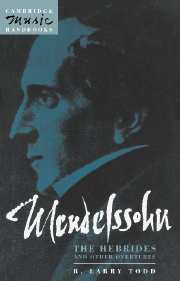7 - Influence and reception of the overtures
Published online by Cambridge University Press: 23 November 2009
Summary
To a large extent the critical reception of Mendelssohn's three overtures paralleled the general reception of the composer, though ultimately the overtures survived the shifting tides of his posthumous fortune to become a cornerstone of his contribution to nineteenth-century romanticism. In Germany and England Mendelssohn's unexpected death in 1847 at age thirty-eight was viewed as an international tragedy, and he was soon memorialized by a remarkably ardent hero-worship usually only accorded dignitaries of the highest rank. The first wave of this adulation crested in 1853, when Elizabeth Sheppard published the novel Charles Auchester, freely based on the life of Mendelssohn, who appeared in its pages idealized as the Chevalier Seraphael. In the fifth chapter of the second volume Sheppard describes an opera, suspiciously similar to the music to A Midsummer Night's Dream, as the very embodiment of the Chevalier's art of ‘blissful modulations’. No title is given for the opera, though its libretto is freely drawn from Shakespeare's The Tempest and A Midsummer Night's Dream. As the curtain goes up – before the overture – Ariel (‘the Ariel of our imaginations, the Ariel of that haunted music’) delivers a prologue. Ariel's soul is ‘native with the spheres/ Where music makes an everlasting morn’. And now he longs to ‘disenchant/ My most melodious treasure breathless hid/ In bell and blade’.
- Type
- Chapter
- Information
- Mendelssohn: The Hebrides and Other Overtures , pp. 89 - 104Publisher: Cambridge University PressPrint publication year: 1993



